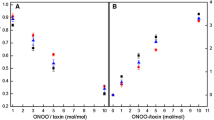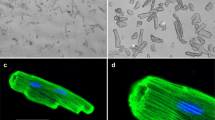Abstract
Sticholysins I and II (St I/II) are cytolysins purified from the sea anemone Stichodactyla helianthus. In this study, we show their pharmacological action on guinea-pig and snail models in native and pH-denatured conditions in order to correlate the pharmacological findings with the pore-forming activity of both isoforms. In guinea-pig erythrocytes (N = 3), St II possessed higher haemolytic activity in comparison with St I and this activity was lost at an alkaline pH. In molluscan central neurons (N = 30), they irreversibly decreased the amplitude of the cholinergic response; St I (EC 50 0.6 µmolL−1) was more potent than St II (EC50 >6.6 µmolL−1) and they both increased the duration of the action potential; these effects were absent at an alkaline pH. In guinea-pig isolated atrium (N = 25), both increased the amplitude of the contraction force, but St II was more potent than St I (EC50 0.03 µmolL−1 and 0.3 µmolL−1, respectively) and this effect persisted at an alkaline pH. In summary, both cytolysins have neuroactive and cardioactive properties. The main mechanism in molluscan neurons seems to be associated with the cytolytic activity of these molecules, whereas in guinea-pig atrium, the existence of an additional pharmacological mechanism might be contributing to the observed effect.
Similar content being viewed by others
Abbreviations
- AA:
-
arachidonic acid
- Ach:
-
acetylcholine
- AP:
-
action potential
- EqTx:
-
equinatoxin
- GABA:
-
gamma aminobutyric acid
- HMg:
-
heteractis magnificalysin
- PBS:
-
phosphate buffered saline
- RBC:
-
red blood cell
- RMP:
-
resting membrane potential
- St I/II:
-
sticholysins I and II
References
Alvarez C A, Pazos I F, Lanio M E, Martinez D, Schreier S, Casallanovo F, Campos A M and Lissi E 2001 Effect of pH on the conformation, interaction with membranes and hemolytic activity of sticholysin II, a pore-forming cytolysin from the sea anemone Stichodactyla helianthus; Toxicon 39 539–553
Alvarez-Valcárcel C A, Dalla Serra M, Potric C, Bernhart I, Tejuca M, Martinez D, Pazos F, Lanio M E and Menestrina G 2001 Effects of lipid composition on membrane permeabilization by sticholysin I and II, two citolysins of the sea anemone Stichodactyla helianthus; Biophys. J. 80 2761–2774
Bunc M, Drevensek G, Buhinda M and Suput D 1999 Effects of equinatoxina from Actinia equina (L.) on isolated rat heart: the role of direct cardiotoxic effects in equinatoxin II lethality; Toxicon 37 109–123
Celedon G, Venegas F, Campos A M, Martinez D, Soto C, Alvarez C and Lissi E 2005 Role of endogenous channels in red blood cells response to their exposure to the pore forming toxin sticholysin II; Toxicon 46 297–307
Cline E 1997 UpI: in vivo studies involving the potent cardiac stimulant and hemolysin from the sea anemone Urticina piscivora; Phytother. Res. 11 348–353
Frangez R, Meunier F and Suput D 2000 Equinatoxin II increases Ca2+ in NG 108-15 cells; Pflugers Arch. (3 Suppl.) 439 100–101
Galletis P and Norton S R 1990 Biochemical and pharmacological studies of the mechanism of action of tenebroxin-C, a cardiac stimulator and hemolytic protein from the sea anemone Actinia tenebrosa; Toxicon 28 695–703
Garatei A, Soto E, Flores A, Garcia-Andrade J M, Vega R, Aneiros A and Palmero A 1996 Antagonism of glutamate receptor by a chromatographic fraction from the sea anemone Phyllactis flosculífera; Toxicon 34 443–450
Ho C L, Ko J L, Lue C, Lee Y and Ferlan I 1987 Effects of equinotoxin on the guinea-pig atrium; Toxicon 25 659–664
Hong Q, Gutierrez-Aguirre I, Barlic A, Malovrh P, Kristan K, Podlesek Z, Macek P, Turk D, Gonzalez-Mañas J M, Lakey J H and Anderluh G 2002 Two-step membrane binding by equinatoxin II, a pore-forming toxin from the sea anemone, involves an exposed aromatic cluster and a flexible helix; J. Biol. Chem. 277 41916–41924
Huerta V, Morera V, Guanche Y, Chinea G, Gonzalez L J, Betancourt L, Martinez D, Alvarez C, Lanio M E and Besada V 2001 Primary structure of two cytolysin isoforms from Stichodactyla helianthus differing in their hemolytic activity; Toxicon 39 1253–1256
Katz A M 1996 Protein families that mediate Ca2+ signalling in the cardiovascular system; Am. J. Cardiol. 28 522–529
Khoo H E, Lim J P C and Tan C H 1995 Effects of sea anemone Heterantis magnifica and Actinia equina cytolisins on synaptosomal uptake of GABA and choline; Toxicon 33 1365–1373
Kostyuk P 1976 Mechanism of electric excitability in the soma of mollusc neurones; Neurobiology of Invertebrates, Gastropoda Brain Tihany 61 307–327
Lanio M E, Morera V, Alvarez C, Tejuca M, Gomez T, Pazos F, Besada V, Martinez D, Huerta V, Padron G and Chavez M A 2001 Purification and characterization of two hemolysins from Stichodactyla helianthus; Toxicon 39 187–194
Lee C, Chen M H and Ferlan I A 1987 Coronary vasospasm as the primary cause of death due to equinatoxin, a toxic protein from Actinia equinia; Toxicon 26 586–588
Martinez D, Campos A M, Pazos F, Alvarez C, Lanio M E, Casallanovo C, Scheirer S, Salinas K R, Vergara C and Lissi E 2001 Properties of St I and St II, two toxins isolated from Stichodactyla helianthus: a comparison; Toxicon 39 1547–1560
Martínez-Soler R, Más R, Menéndez R and Garateix A 1983 Distinción farmacológica de los receptores a la Ach y al L-glu presentes en una misma célula; Ciencias Biol. 10 28–45
Migues P V, Leal R B, Mantovani M, Nicolau M and Gabilan N H 1999 Synaptosomal glutamate release induced by the fraction Bc2 from the venom of the sea anemone Bunodosoma caissarum; Neuroreport 10 67–70
Sainz D F, Miyares C and García M 1972 Técnicas de farmacología experimental (Cuba: Ciencia y Técnica); Chapter 2, pp 97–99
Tejuca M, Serra S M, Ferreras M, Lanio M E and Menestrina G 1996 Mechanism of membrane permeabilization by sticholysin, a cytolysin isolated from the sea anemone Stichodactyla helianthus; Biochemistry 35 14947–14957
Author information
Authors and Affiliations
Corresponding author
Rights and permissions
About this article
Cite this article
García, T., Martinez, D., Palmero, A. et al. Pharmacological effects of two cytolysins isolated from the sea anemone Stichodactyla helianthus . J Biosci 34, 891–898 (2009). https://doi.org/10.1007/s12038-009-0103-6
Received:
Accepted:
Published:
Issue Date:
DOI: https://doi.org/10.1007/s12038-009-0103-6




